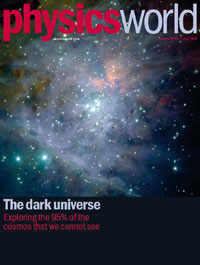By Matin Durrani
Unless you’re prepared to modify our understanding of gravity – and most physicists are not – the blunt fact is that we know almost nothing about 95% of the universe. According to our best estimates, ordinary, visible matter accounts for just 5% of everything, with 27% being dark matter and the rest dark energy.
The July issue of Physics World, which is out now in print and digital formats, examines some of the mysteries surrounding “the dark universe”. As I allude to in the video above, the difficulty with dark matter is that, if it’s not ordinary matter that’s too dim to see, how can we possibly find it? As for dark energy, we know even less about it other than it’s what is causing the expansion of the universe to accelerate and hence making certain supernovae dimmer (because they are further away) than we’d expect if the cosmos were growing uniformly in size.
First up in the July issue is Tamara Davis from the Unviersity of Queensland, who shows how we can gain insights into the dark universe by detecting the sound waves from the early cosmos, known as “baryon acoustic oscillations”, that have left an imprint on the structure of galaxies. Jeff Forshaw from the University of Manchester looks at some of our current theories of dark matter and dark energy, while Catherine Heymans from the University of Edinburgh explains how to learn more about dark matter by seeing how light from distant galaxies is distorted through “gravitational lensing”.
 The issue also has a great flowchart itemizing some of the myriad candidates for dark matter. In fact, if you’re accessing Physics World through our digital edition, you can enjoy the flowchart in a fantastic interactive form. I do encourage you to access the digital edition, which from this month has a great new look. We’ll be constantly updating the features and functionality, so do e-mail us with any comments or thoughts on it.
The issue also has a great flowchart itemizing some of the myriad candidates for dark matter. In fact, if you’re accessing Physics World through our digital edition, you can enjoy the flowchart in a fantastic interactive form. I do encourage you to access the digital edition, which from this month has a great new look. We’ll be constantly updating the features and functionality, so do e-mail us with any comments or thoughts on it.
If you’re a member of the Institute of Physics (IOP), you can enjoy get immediate access to the new issue via the digital edition of the magazine on desktop via MyIOP.org or via the Physics World app, available from the App Store. (Please note that the new Android version from Google Play is not ready yet but will be available soon.) If you’re not yet in the IOP, you can join as an IOPimember for just £15, €20 or $25 a year to get a full year’s access to Physics World both online and through the apps.
For the record, here’s a a run-down of the highlights of the July issue.
• Germany quits €2bn radio telescope – James Dacey reports on why Germany is pulling out of the Square Kilometre Array
• Axe looms for European Research Foundation – The ESF could be closed by the end of the year as many of its members look to Brussels, as Edwin Cartlidge finds out
• Mathematical bridges – Physicists should learn form the mathematical community’s annual Bridges conferences, says Robert P Crease
• Sounding out higher fees – Students from England have recently been hit by steep rises in tuition fees. Arti Argawal asks whether the decision to do so – based on free-market economics – was right
• Sounding out cosmic ripples – Sound waves frozen into place as the early universe expanded left an imprint in the structure of galaxies that has now been mapped in detail. Tamara Davis describes how these baryon acoustic oscillations formed and what they can tell us about dark matter and dark energy
• What’s the matter? – Dark matter is the name given to the mysterious stuff that makes up 27% of the universe. This flowchart, composed by Louise Mayor, guides you through the many options for what it could be
• Theories of the dark side – Dark matter and dark energy represent serious challenges to our understanding of the cosmos but, as Jeff Forshaw explains, the next few years promise to be exciting ones for theorists and experimentalists alike as we begin to uncover the nature of the dark sector
• Seeing the invisible – Light from distant galaxies is distorted on its journey to us via a vast network of dark matter. By observing this phenomenon, known as gravitational lensing, physicists are able to map the structure of this dark cosmic web, as Catherine Heymans explains
• Electricity, eels and evolution – Brian Rasnow reviews Spark from the Deep:Deep: How Shocking Experiments with Strongly Electric Fish Powered Scientific Discovery by William J Turkel
• A century of general relativity – Cormac O’Raifeartaigh reviews The Perfect Theory: a Century of Geniuses and the Battle Over General Relativity by Pedro G Ferreira
• Physics and babies’ bottoms – As a leading researcher for Procter & Gamble’s brand of nappies, Mattias Schmidt says there’s plenty of physics at the business end of the consumer goods market
• Once a physicist – Martin Fischer is a boat designer who specializes in the deisgn of racing catamarans
• Lateral Thoughts: Quantum kung fu – Felix Flicker describes how quantum physics can get you out of an arm lock
“… Dark matter and dark energy represent serious challenges to our understanding of the cosmos …” Can string theory explain dark matter and dark energy? Is Milgrom the Kepler of contemporary cosmology? Does Milgrom’s MOND explain the space roar and the photon underproduction crisis?
http://en.wikipedia.org/wiki/Space_roar
http://en.wikipedia.org/wiki/Photon_underproduction_crisis
http://www.weizmann.ac.il/weizsites/milgrom/lectures-and-presentations/
Trackback: Video: A look at the Square Kilometre Array (SKA) | CQG+